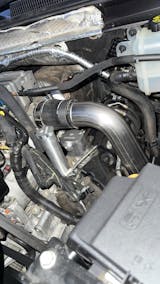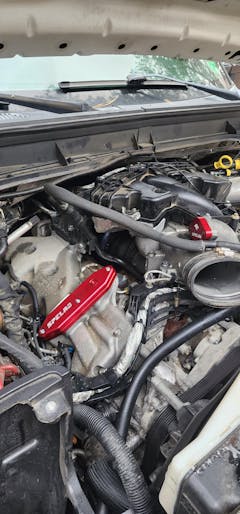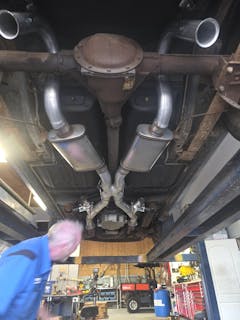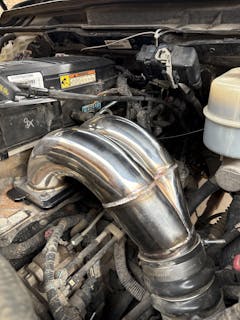Q1: What is a CCV system?
A1: CCV filter stands for “Crankcase Ventilation” On all diesels and especially the L5P the CCV is connected to a valve cover to extract the combustion gasses that have entered the crankcase via bypassing the piston rings, and other gasses as the result of oil aeration. The CCV system connects to the factory intake or intake manifold, in the case of diesels – the intake air horn. The factory intake air horn draws a vacuum across the CCV system by way of BERNOULLIS PRINCIPAL to pull crankcase gases out of the engine and reburn them in the motor. The problem is often as a diesel wears out they endup with a lot of blow by and oil injection into the inlet of the turbo. The truck consumes this oil as part of emissions standards and best practices of crank case evacuation.
Q2: How does the CCV upgrade system work once installed?
A2: The CCV upgrade system, once installed, allows for more efficient removal of oil from the CCV supply line using two integrated differential drop devices in the CCV block. This method, commonly used in marine and high-output diesel applications, is passive and has no moving parts. It helps maintain a clean intake track and prevents hot air and oil from entering the system.
Q3: Why is the factory CCV system problematic?
A3: The factory CCV system tends to fail over time, and when it does, it allows boost pressure from the CCV to enter the intake track through the intake air horn. Additionally, it is not serviceable, and replacing it requires removing the entire driver's side valve cover, including injectors and fuel lines, which is time-consuming and costly.
Q4: What is the advantage of removing the factory CCV component?
A4: Removing the factory CCV component eliminates a potential failure point and provides a more convenient and safe oil fill location at the front of the motor. It also separates the CCV system from the oil fill port for safety reasons.
Q5: What is a CCV Reroute/Delete Kit?
A5: It is a kit that reroutes or deletes the crankcase ventilation system to reduce oil contamination and improve engine performance.
Q6: What vehicles does this kit fit?
A6: It fits 2017-2024 L5P 6.6L Duramax Diesel GMC Sierra 2500 3500 HD and Chevrolet Silverado 2500 3500 HD.
Q7: What are the benefits of using this kit?
A7: Benefits include improved engine performance, reduced oil contamination, and increased engine longevity.
Q8: Is the installation of this kit difficult?
A8: The installation is straightforward and can be done with basic tools, following the provided instructions.
Q9: Will using this kit void my vehicle's warranty?
A9: It may void certain parts of the vehicle's warranty. It's best to check with your manufacturer or dealer.
Q10: Do I need any special tools to install this kit?
A10: No special tools are required, just standard automotive tools.
Q11: How long does the installation take?
A11: Installation typically takes about 1-2 hours.
Q12: Does this kit improve fuel economy?
A12: Yes, it can contribute to better fuel economy by improving engine efficiency.
Q13: Is this kit legal for street use?
A13: The legality can vary by location. It's important to check local emissions regulations.
Q14: Where can I find the installation guide?
A14: The installation guide is available on the SPELAB website or included with the kit.

PLEASE NOTE!
CCV Reroute/Delete kit Installtion Guide












































